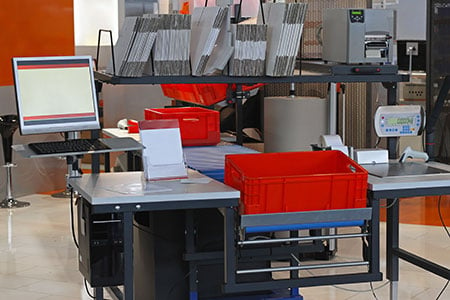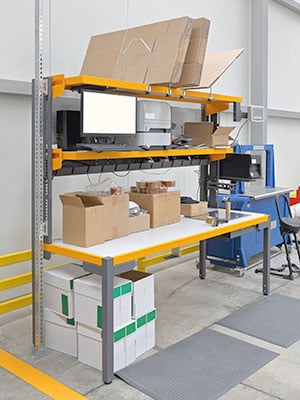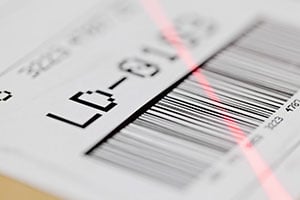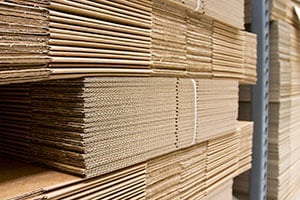11 Best Shipping Station Layout & Setup Tips
 Industrial shipping and packing stations play a critical role in the modern warehousing cycle. This is where products should be thoroughly prepared prior to shipping.
Industrial shipping and packing stations play a critical role in the modern warehousing cycle. This is where products should be thoroughly prepared prior to shipping.
Functions handled here include checking products, packaging them, and finally, labeling so they can easily be identified. These tasks can play heavily into the shipping process; without proper labeling, for example, items may not be sent to the correct destinations. Similarly, product checks are critical to ensuring accurate fulfillment.
There's no denying the importance of the shipping station, but this space often fails to live up to its full potential. Even as receiving areas and warehouse pallet systems are upgraded and optimized, enterprises may treat shipping stations as an afterthought.
In this guide, we highlight strategies for improving these workspaces, with the ultimate goal of improving efficiency while also enhancing the packing and labeling experience for hardworking employees.
11 Shipping Station Setup Tips
If your shipping station could use a boost, you'll want to begin by taking a close look at your current setup to reveal where, exactly, there is room for improvement. Where do bottlenecks typically occur?
Next, consider the type or variety of items that need to be shipped. From there, you can follow these suggestions to optimize this critical space:
1. Define the Workspace
Your shipping station should not look or feel haphazard. It deserves a dedicated and defined space, where it's clear what, exactly, will take place.
Don't underestimate how much space shipping and packing operations require; packers need space to maneuver without feeling cramped. That being said, excessive space must also be avoided, as constant reaching or straining will make employees uncomfortable while dramatically slowing down the pace of your packing operation.
2. Identify Necessary Equipment & Supplies
It takes many moving parts to complete the packing process. While no two facilities will feature the exact same tools or supplies, the following warrant consideration:
 Shelving. Boost ease of access by implementing a strategically designed shelving system that helps workers reach supplies when or how they need them. Different types of materials will call for different shelving solutions. For example: vertical staging is often preferable for certain packing materials, as it limits the need for high reaches or low bends.
Shelving. Boost ease of access by implementing a strategically designed shelving system that helps workers reach supplies when or how they need them. Different types of materials will call for different shelving solutions. For example: vertical staging is often preferable for certain packing materials, as it limits the need for high reaches or low bends.- Work tables. Forming the basis of every packing operation, work tables provide an optimized space where employees can complete a variety of important tasks with ease. These tables need to provide a sufficiently large surface area but should also be designed and selected with comfort and durability in mind.
- Boxes, tape and labels. Determine which materials will be needed to properly pack and identify shipments. How these are stored and dispensed matters, so integrate time-saving solutions whenever possible. Packing tables should have quick and easy access to shipping boxes, bubble wrap, shipping labels, and other packing supplies integral to warehouse packing.
- Case sealers and stretch wrappers. Case sealers improve efficiency by streamlining the sealing process, reducing labor costs, and ensuring consistent, secure packaging for every shipment. Stretch wrappers place protective film around materials and are often a critical component of the packing process. Other wrapping solutions may also be required, such as scales or banding equipment.
3. Assign Storage Areas for Each Item
We've already mentioned the need for ample, carefully placed storage shelves to keep supplies accessible — but simply installing them isn't enough. Each space needs to be organized with storage areas that reflect where each type of item should be kept. This simple step can prevent a lot of confusion, thereby optimizing your packing station's workflow.
4. Use Labeling Systems
 Before shipments can proceed, they need to be accurately labeled. This is one of the most critical components of the packing process, as it determines whether items will be shipped to the right place and the right person — and, of course, at the right time. Other details may also be required, such as an indication as to whether shipments may be fragile.
Before shipments can proceed, they need to be accurately labeled. This is one of the most critical components of the packing process, as it determines whether items will be shipped to the right place and the right person — and, of course, at the right time. Other details may also be required, such as an indication as to whether shipments may be fragile.
Labeling can prove surprisingly complicated, but a carefully designed system can limit employee confusion and expedite this process. Label dispensers are a must; many operations include wall-mount solutions that save space and are easy for employees to access.
5. Implement a First-In, First-Out System
First-in, first-out (FIFO) represents a common inventory management setup, in which the initial items to enter a space are also the first to leave. While it's not always ideal for palletizing, it's an excellent arrangement for shipping stations.
When FIFO enters the packing equation, employees are better capable of focusing on the task at hand, before promptly sending packed and labeled items on their way. Often, restocking occurs from the back of the station; this minimizes disruptions so employees can continue to work.
6. Create a Schedule for Maintenance & Cleaning
 From boxes to bubble wrap to packing peanuts, it doesn't take long for shipping stations to feel cluttered. Even if you've dedicated a lot of space to shipping operations, the area will quickly start to feel confined if you don't keep on top of your cleaning regimen. What's more, clutter could be a significant safety hazard. Keep it at bay with an easy-to-follow schedule that ensures the area is regularly cleaned.
From boxes to bubble wrap to packing peanuts, it doesn't take long for shipping stations to feel cluttered. Even if you've dedicated a lot of space to shipping operations, the area will quickly start to feel confined if you don't keep on top of your cleaning regimen. What's more, clutter could be a significant safety hazard. Keep it at bay with an easy-to-follow schedule that ensures the area is regularly cleaned.
Scheduling should go beyond simple cleaning to include regular maintenance. This is especially important if your shipping area contains advanced tech solutions.
7. Optimize Workspace Layout
 Small ergonomic tweaks can make a huge difference for your shipping and packaging areas. Ample space is often valuable, but there's a lot more to an optimized layout than square footage alone.
Small ergonomic tweaks can make a huge difference for your shipping and packaging areas. Ample space is often valuable, but there's a lot more to an optimized layout than square footage alone.
Consider the flow of your packing and shipping procedures and develop configurations that accommodate this. The ultimate goal is to limit the need for employees to move about the shipping area; they should be able to remain at their workstations and maintain a steady pace.
Linear station designs are the gold standard for many packing operations. These involve a simple and easy-to-follow workflow, typically encompassing quality assurance, packing list checks, protecting and packing items, and finally, labeling. Increasingly, however, operations aim to limit human touches, with the goal of preventing the need for objects (or employees) to constantly move about. It is often this movement that is responsible for packing area inefficiency.
The height of each element must also be considered. Many facilities rely on the waterfall concept to ensure that packages are placed at the same height as the incoming products. Slanted box stands can also be helpful, as these make items easier to access when dealing with large or heavy boxes.
8. Implement Safety Measures
When you picture warehouse accidents or injuries, you probably imagine forklifts or high shelves. While picking certainly prompts its fair share of hazards, it's also possible to get hurt in seemingly safe shipping areas.
To limit the risk of injury, develop worker-centric designs that limit the need for employees to constantly bend over or lift heavy objects. Solutions such as water-activated tape can also help, as these limit everyday strain to reduce the risk of repetitive motion injuries.
9. Train Employees on Proper Organization Techniques
 None of the strategies highlighted above will be particularly impactful if your employees fail to follow through. With targeted training, however, you can help them maintain an efficient and effective approach to packing organization. Remind them that this will make their jobs easier, as your process will have been purposefully created with the intention of preventing physical strain.
None of the strategies highlighted above will be particularly impactful if your employees fail to follow through. With targeted training, however, you can help them maintain an efficient and effective approach to packing organization. Remind them that this will make their jobs easier, as your process will have been purposefully created with the intention of preventing physical strain.
Organization techniques can be applied to every aspect of the packing process. First, each workstation should be organized, so necessary materials are always available. Additionally, employees should understand the proper workflow, as well as strategic methods for packing to keep items secure.
10. Use Technology to Streamline Processes
A variety of cutting-edge tools and technologies promise to optimize shipping processes. These solutions may sometimes be costlier to implement, but they can prompt considerable savings over time by improving accuracy and efficiency while also reducing physical strain. Examples include:
- Box forming. Folding can be one of the most labor-intensive and strain-inducing aspects of the packing workflow, but automated solutions can take over to limit the burden on employees.
 Case sealers and wrap machines. While manual case sealers and wrapping machines are still commonplace in packing operations, many facilities have embraced automation to great effect.
Case sealers and wrap machines. While manual case sealers and wrapping machines are still commonplace in packing operations, many facilities have embraced automation to great effect.- Conveyors. Optimize the movement of items throughout the packing area with a strategic system of conveyors. This allows employees to remain at their stations while also limiting the need for heavy lifting.
- Order fulfillment software. Track items throughout the entire order fulfillment process with high-level software that provides oversight every step of the way. The value of these systems for picking is well-known, but don't forget that it also has a critical role to play in packaging.
11. Continuously Evaluate & Improve the Shipping Station
 Shipping organization is a process, not a one-time affair. Chances are, your needs or requirements will evolve over time — and you'll want to make adjustments along the way to accommodate these shifts.
Shipping organization is a process, not a one-time affair. Chances are, your needs or requirements will evolve over time — and you'll want to make adjustments along the way to accommodate these shifts.
Gather metrics (such as orders shipped per hour) to evaluate how long critical processes take and how your process evolves over time. Ideally, you will see a marked improvement as soon as you implement the suggestions outlined above.
Employee input can also be valuable. Packers should be well aware of where material handling bottlenecks typically occur and may provide valuable insight into how these might be resolved. Encourage them to share their thoughts, as this could improve not only the shipping process but also employee satisfaction and morale.
Boost Your Shipping Strategy With Warehouse1
As you optimize your warehouse's layout and design, don't neglect your shipping space. No matter which areas in your order fulfillment process call for upgrades, you can count on the Warehouse1 team for excellent insight. Contact us today to learn more about our packing-oriented products and services.



